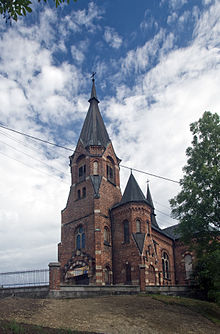Biegonice
| Biegonice | ||
|---|---|---|

|
|
|
| Basic data | ||
| State : | Poland | |
| Voivodeship : | Lesser Poland | |
| Powiat : | Nowy Sącz | |
| Gmina : | Nowy Sącz | |
| Area : | 6.23 km² | |
| Geographic location : | 49 ° 35 ' N , 20 ° 40' E | |
| Height : | 297 m npm | |
| Residents : | 1449 (2018) | |
| Postal code : | 33-300 | |
| Telephone code : | (+48) 18 | |
| License plate : | KN | |
Biegonice ( German Laufendorf ) is a southwestern part of Nowy Sącz in the Lesser Poland Voivodeship in Poland , halfway between the city center and Stary Sącz , on the right bank of Dunajec .
history
In Biegonice there was a Slavic rampart in the early Middle Ages .
The place was first mentioned in 1280 as Baganicy in the founding privilege of the monastery of the Poor Clares in (Stary) Sącz . The patronymic name is derived from the personal name Biegan (in the 16th century the vowel -a- increased to -u- or -o-). With Barcice it became a model village of the German law foundations by the Poor Clares, mentioned several times in their founding privileges up to the year 1330. In 1288 the first wooden church was built.
Politically and administratively, the village belonged to the Kingdom of Poland (from 1569 the aristocratic republic of Poland-Lithuania ), Krakow Voivodeship , Sącz District.

During the first partition of Poland in 1772, Biegonice became part of the new Kingdom of Galicia and Lodomeria of the Habsburg Empire (from 1804). In 1783, as part of the Josephine colonization, German settlers of mixed denominations were settled east of the village. At that time the place received the German surname Laufendorf , a free translation of the Polish verb biegać (to run) with the suffix -dorf. The Protestants belonged to the parish in Nowy Sącz. The first Jews settled here in 1857. In 1900 the municipality of Laufendorf, Biegonice had an area of 642 hectares, with 95 houses and 694 inhabitants, of which 655 were Polish-speaking and 39 German-speaking, apart from 623 Roman Catholics, there were 13 Jews and 58 of other faiths.
In 1918, after the end of the First World War and the collapse of the Austro-Hungarian monarchy, Biegonice came to Poland. This was only interrupted by the occupation of Poland by the Wehrmacht in World War II .
Biegonice was gradually incorporated into Nowy Sącz from 1974 to 1977.
Attractions
- Roman Catholic Lorenz Church, built 1906 to 1909
Individual evidence
- ↑ a b Tomasz Jurek (editor): BIEGONICE ( pl ) In: Słownik Historyczno-Geograficzny Ziem Polskich w Średniowieczu. Edycja elektroniczna . PAN . 2010-2016. Retrieved April 22, 2019.
- ↑ Kazimierz Rymut , Barbara Czopek-Kopciuch: Nazwy miejscowe Polski: historia, pochodzenie, zmiany . 1 (AB). Polska Akademia Nauk . Instytut Języka Polskiego, Kraków 2004, p. 167 (Polish, online ).
- ↑ Henryk Lepucki: Działalność kolonizacyjna Marii Teresy i Józefa II w Galicji 1772-1790: z 9 tablicami i MAPA . Kasa im. J. Mianowskiego, Lwów 1938, p. 163-165 (Polish, online ).
- ↑ Schematism of the Evangelical Church in Augsb. and Helvet. Confession in the kingdoms and countries represented in the Austrian Imperial Council . Vienna 1875, p. 190 ( online ).
- ↑ Ludwig Patryn (Ed.): Community encyclopedia of the kingdoms and countries represented in the Reichsrat, edited on the basis of the results of the census of December 31, 1900, XII. Galicia . Vienna 1907 ( online ).
Web links
- Biegonice . In: Filip Sulimierski, Władysław Walewski (eds.): Słownik geograficzny Królestwa Polskiego i innych krajów słowiańskich . tape 1 : Aa-Dereneczna . Sulimierskiego and Walewskiego, Warsaw 1880, p. 207 (Polish, edu.pl ).
- Biegonice . In: Filip Sulimierski, Władysław Walewski (eds.): Słownik geograficzny Królestwa Polskiego i innych krajów słowiańskich . tape 15 , part 1: Abablewo – Januszowo . Walewskiego, Warsaw 1900, p. 136 (Polish, edu.pl ).

